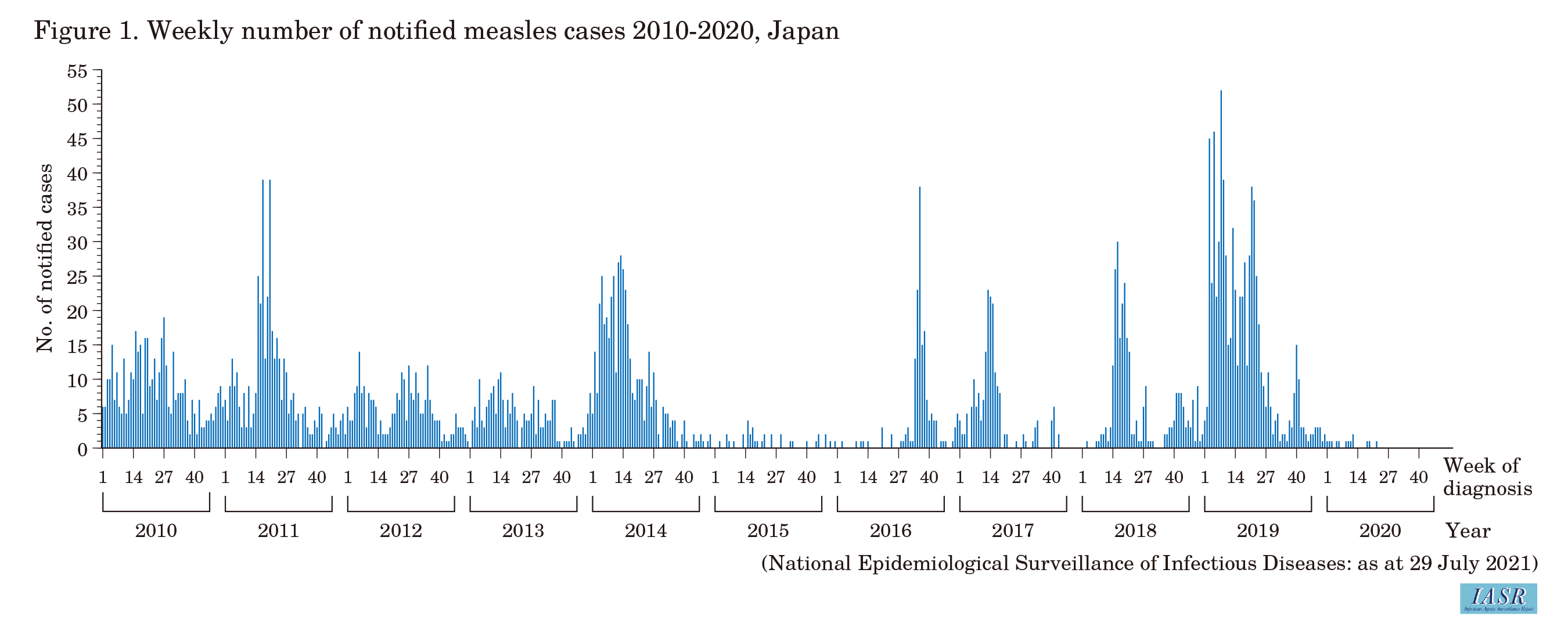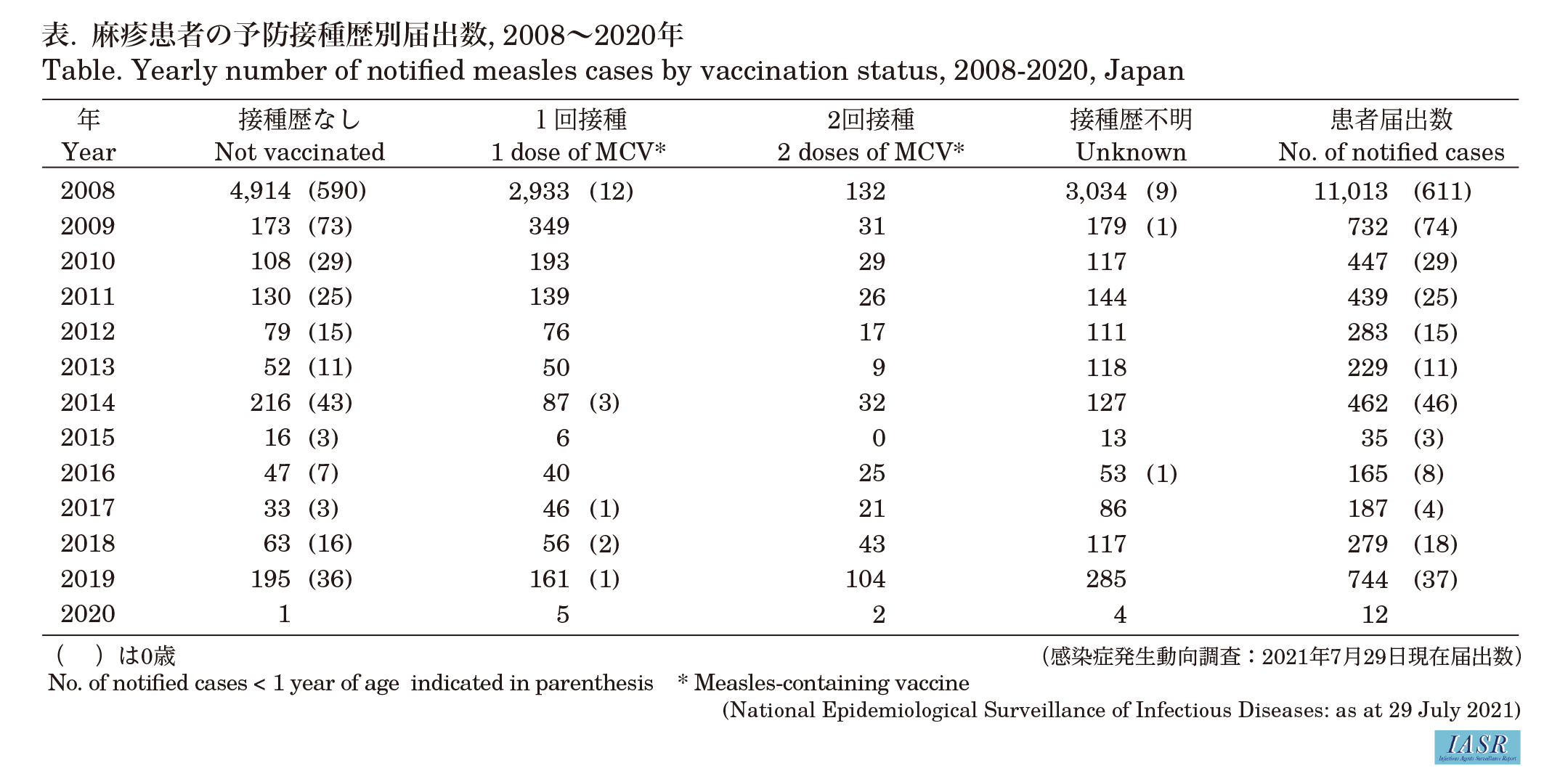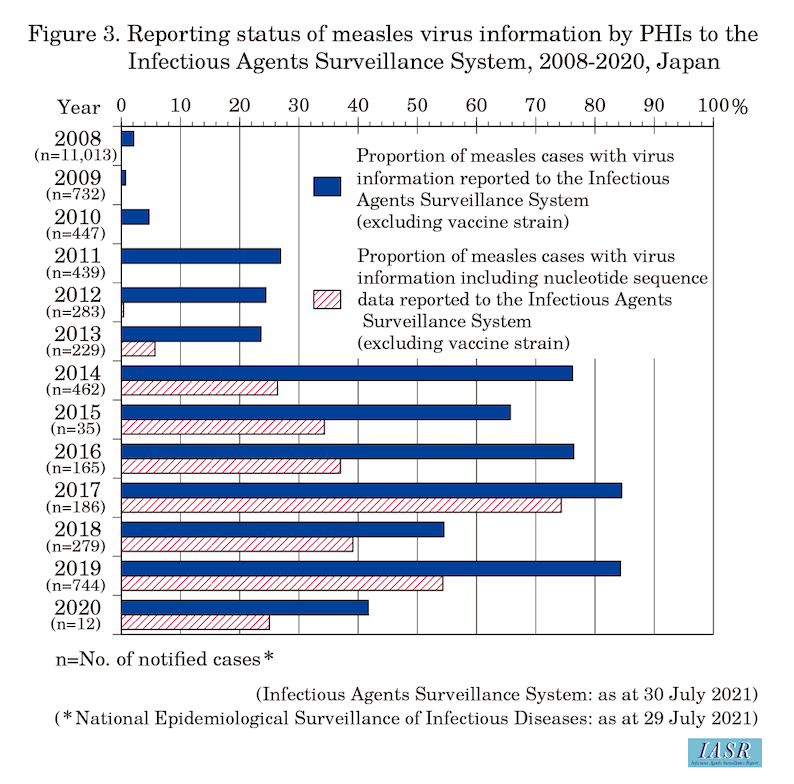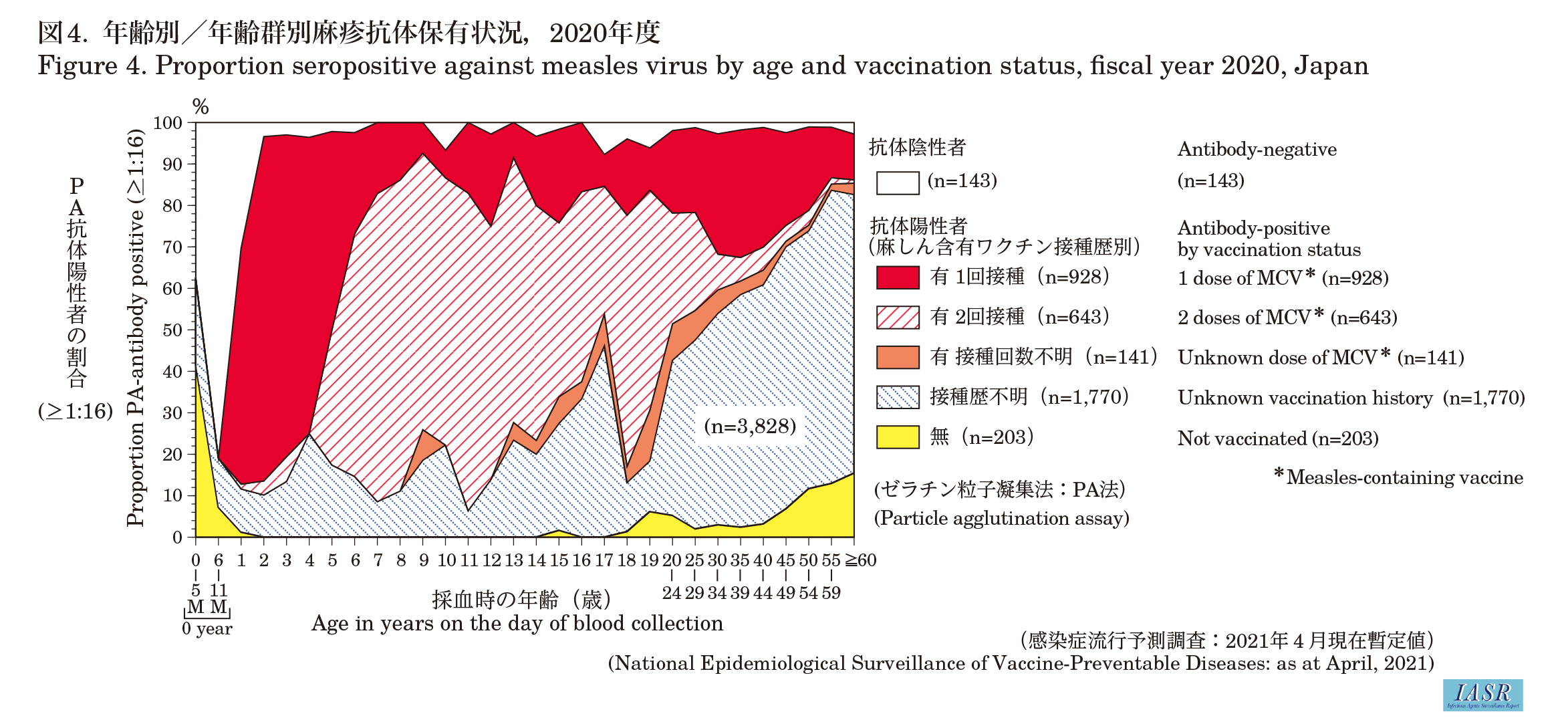IASR 42(9), 2021【THE TOPIC OF THIS MONTH】Measles in Japan as at July 2021
PDF download(PDF:523.00KB)
The topic of This Month Vol.42 No.9(No. 499)
Measles in Japan as at July 2021
(IASR Vol. 42 p177-179: September 2021)
Measles is an acute infectious disease caused by the measles virus. The main symptoms are fever, rash, and catarrhal symptoms. Since the measles virus infects immune cells, the virus suppresses the immune function of infected individuals, causing complications, such as otitis media, enteritis, encephalitis, and pneumonia, in about 30% of infected individuals, and in cases of complications such as pneumonia and encephalitis, death may occur. Although rare, patients may develop encephalitis with a poor prognosis known as subacute sclerosing panencephalitis (SSPE) (see p.180 of this issue). Measles virus infection occurs not only by droplet and contact transmission but also by airborne transmission, and is highly contagious.
For 2019, the World Health Organization (WHO) estimates 207,500 deaths from measles worldwide, an increase of approximately 50% from 2016 (https://www.who.int/news/item/12-11-2020-worldwide-measles-deaths-climb-50-from-2016-to-2019-claiming-over-207-500-lives-in-2019).
On the other hand, measles is considered an infectious disease that can be eliminated because humans are the only natural host for the measles virus, an effective vaccine is available, subclinical infections are rare, and accurate diagnostic methods are available; WHO is thus aiming for measles elimination. In 2005, the WHO regional committee for the Western Pacific, the region to which Japan belongs, resolved to eliminate measles from the WHO Western Pacific Region (WPR). In response to this, in Japan, a two-dose measles vaccination schedule (the first dose for 1-year-old children and the second dose for children during the year prior to elementary school entry) was introduced in 2006. In December 2007, the Ministry of Health, Labour and Welfare (MHLW) issued the “Guidelines for the Prevention of Specific Infectious Diseases: Measles” (final revision in April 2019, hereinafter referred to as the “Guidelines”) and took countermeasures, including implementation of the catch-up immunization program for age groups corresponding to the first year of junior high school and the third year of high school as a routine vaccination for 5 years (from 2008 to 2012), to increase immunity against measles among teens who were at the center of the epidemic at that time. As a result, the number of measles patients has greatly decreased since 2009, and the Regional Verification Committee (RVC) of the WHO WPR verified in March 2015 that Japan had achieved measles elimination status. This status has been confirmed and accredited through 2018, and thereafter RVC is verifying the status through 2020.
Measles notification under the National Epidemiological Surveillance of Infectious Diseases system: Measles is a category V infectious disease according to the “Act on the Prevention of Infectious Diseases and Medical Care for Patients with Infectious Diseases” (referred to as the Infectious Diseases Control Law) (for the notification criteria and disease classification, see: http://www.niid.go.jp/niid/images/iasr/35/410/de4101.pdf). The number of measles cases reported in 2008, when all measles cases became notifiable, was 11,013 and has remained between 35 and 744 through 2019; since 2009, the highest number of cases (744 cases) was reported in 2019 and the lowest number of cases (12 cases) was reported in 2020 (Fig. 1).
In terms of disease classification of the patients reported in 2020 (n=12), 5 of 12 (42%) were modified measles, which are laboratory-confirmed, atypical cases with only one or two of the three main symptoms (fever, rash, and catarrhal symptoms). The presumed place of infection was Japan in 7 cases, Thailand in 3 cases, Brazil or Japan in 1 case, and unknown in 1 case.
Regarding the age distribution, 6 cases were under 20 years of age and 6 cases were 20 years or older (Fig. 2).
As for vaccination history, there was 1 who was unvaccinated, 5 who received one dose, 2 who received two doses, and 4 with an unknown vaccination history; there were no cases under <1 year of age, the age group prior to the initiation of routine measles vaccination (Table).
Current practice regarding laboratory diagnosis: In principle, the Guidelines require that all suspected measles cases be tested for IgM antibodies and viral genes. Specimens for IgM antibody testing are sent from healthcare facilities to private laboratories, and specimens for genetic testing are sent mainly from healthcare facilities to the prefectural and municipal public health institutes (PHIs) for testing. In 2020, 11 of 12 cases were reported as laboratory-diagnosed cases, and 5 cases were positive by genetic testing. For the genetic testing, the real-time RT-PCR method is used to detect viral genes, and the Guidelines recommend that positive specimens be analyzed for the 450 bases of the genotyping site on the measles virus N gene. The obtained base sequence is used not only for genotyping, but also for differentiation from vaccine strains, confirmation of epidemiological links in outbreaks, and differentiation between imported and non-imported cases.
Detection of measles virus (Infectious Agents Surveillance System): The number of virus detections at PHIs reported to the National Epidemiological Surveillance of Infectious Diseases (NESID) system’s Infectious Agents Surveillance System in 2020 was 5 (12 total measles cases), excluding vaccine strains (Fig. 3). All reported viral genotypes were classified as genotype D8.
Vaccination coverage: Since its introduction in fiscal year (FY) 2006, the 2-dose vaccination approach using the measles and rubella (MR) vaccine has been used in the routine immunization program. In FY2019, the vaccination coverage (including measles single-antigen vaccination) was 95.4% for the first dose and 94.1% for the second dose (https://www.mhlw.go.jp/bunya/kenkou/kekkaku-kansenshou21/dl/201014-01.pdf). Although the overall national vaccination coverage of the first dose exceeded the target of 95%, 17 prefectures remained at a coverage level between 90 and 95%. The overall coverage of the second dose exceeded 90% for 12 consecutive years, but was slightly short of 95%. Only 17 prefectures had a vaccination coverage higher than 95%.
Measles seroprevalence under the National Epidemiological Surveillance of Vaccine-Preventable Diseases (NESVPD): In FY2020, the measles seroprevalence survey under NESVPD was conducted by PHIs in 18 prefectures by measuring the measles gelatin particle agglutination (PA) antibody titer (see p.181 of this issue). The blood collection period mostly ran from July to September 2020. Seroprevalence with a measles PA antibody titer 1:16 or higher was 98% in those aged 2 years and older, but the seroprevalence among one-year-olds was 69.8%, down to 11.8 points from the previous year (Fig. 4).
Future measures: In 2019, the number of measles cases worldwide was about 870,000, the highest since 1996, and decreased substantially to about 94,000 in 2020, but measles is still circulating in many countries (see p.183 of this issue). In 2020, the number of foreign visitors to Japan decreased considerably to 4.11 million, down 87% from the previous year due to the global outbreak of COVID-19 (https://www.jnto.go.jp/jpn/statistics/data_info_listing/pdf/210120_monthly.pdf). The risk of measles introduction by visitors to Japan is thought to have decreased, but is believed to rise if countermeasures against COVID-19 advance and the situation changes in the future, such as an increase in the number of foreign visitors to Japan or an increase in the number of Japanese traveling abroad.
In addition, since it is dif ficult to prevent the entry of the measles virus from overseas, it is essential to prepare an environment in which infection does not spread even if the virus is imported (see pp.184 and 185 of this issue). To this end, the following are required: 1) maintain at least 95% vaccination coverage of 2 doses of routine vaccination and maintain a high seroprevalence among the general population; 2) further strengthen surveillance so that case-patients can be detected early and appropriate measures can be taken, based on confirmatory laboratory testing, to prevent the further spread of infection (see pp.187, 189, and 190 of this issue); 3) recommend vaccination as necessary for healthcare workers, overseas travelers, those who work in airports and other workplaces where there are many opportunities for contact, and workers at child welfare facilities and schools, all of whom are at a high risk of infection. In addition, to contribute to eff icient surveillance activities, it is also important to promote information sharing among local authorities and international cooperation (see p.192 of this issue).

